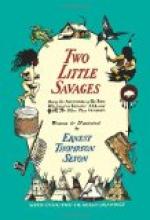Another wire was sharpened and driven through the bones of the tail, fastening that also to the tow body (Tw, Fig. 7).
Now a little soft tow was packed into places where it seemed needed to fit the skin on, and it remained to sew up the opening below (Bc in Fig. 6), the wing slits (El, H, Fig. 6 and Fig. 1), and the slit in the nape (Sn Sn, Fig. 2) with half a dozen stitches, always putting the needle into the skin from the flesh side.
The projecting wires of the feet were put through gimlet holes in the perch and made firm, and Si’s Owls were ready for their positions. They were now the most ridiculous looking things imaginable, wings floppy, heads hanging.
“Here is where the artist comes in,” said Si proudly, conscious that this was himself. He straightened up the main line of the body by bending the leg wires and set the head right by hunching the neck into the shoulders. “An Owl always looks over its shoulder,” he explained, but took no notice of Sam’s query as to “whose shoulder he expected it to look over.” He set two toes of each foot forward on the perch and two back to please Yan, who insisted that that was Owly, though Si had his doubts. He spread the tail a little by pinning it between two pieces of card (Tl, Fig. 10), gave it the proper slant, and now had the wings to arrange.
They were drooping like those of a clucking hen. A sharp wire of the small size was driven into the bend of each wing (0, Fig. 7), nailing it in effect to the body (Ww and Ww, Fig. 10). A long pin was set in the middle of the back (Bp, Fig. 10), then using these with the wing wires and head wire as lashing points, Si wrapped the whole bird with the thread (Fig. 10), putting a wad of cotton here or a bit of stick there under the wrapping till he had the position and “feathering” perfect, as he put it.
“We can put in the eyes now,” said he, “or later, if we soften the skin around the eye-sockets by putting wet cotton in them for twenty-four hours.”
Yan had carefully copied Si’s method with the second Owl, and developed unusual quickness at it.
His teacher remarked, “Wall, I larned lots o’ fellows to stuff birds, but you ketch on the quickest I ever seen.”
Si’s ideas of perfection might differ from those of a trained taxidermist; indeed, these same Owls afforded Yan no little amusement in later years, but for the present they were an unmitigated joy.
They were just the same in position. Si knew only one; all his birds had that. But when they had dried fully, had their wrappings removed, the wires cut off flush and received the finishing glory of their wooden eyes, they were a source of joy and wonder to the whole Tribe of Indians.
XIX
The Trial of Grit




